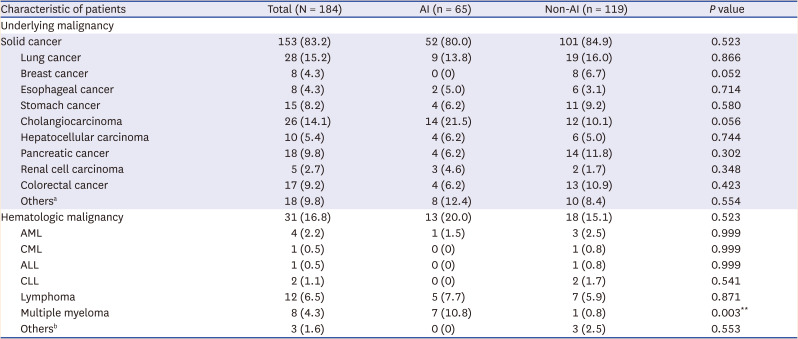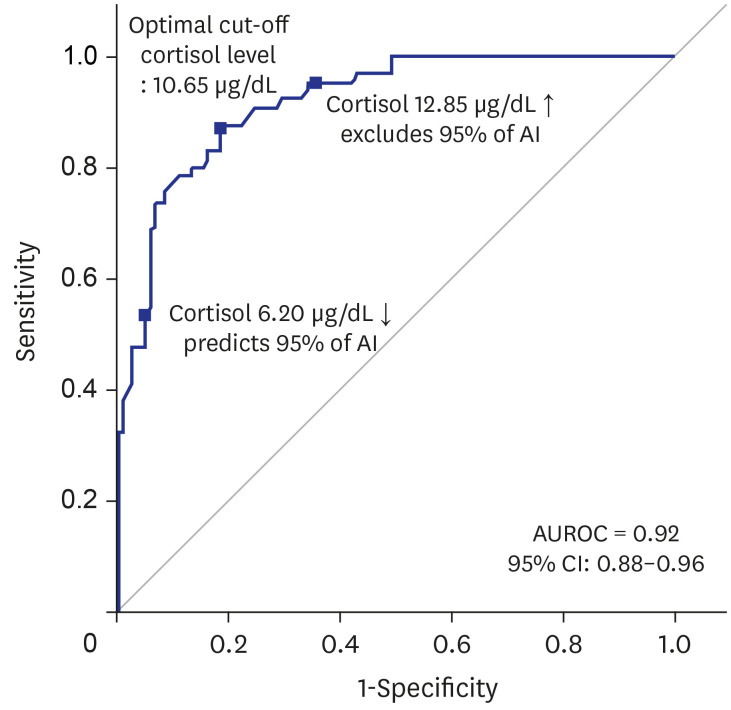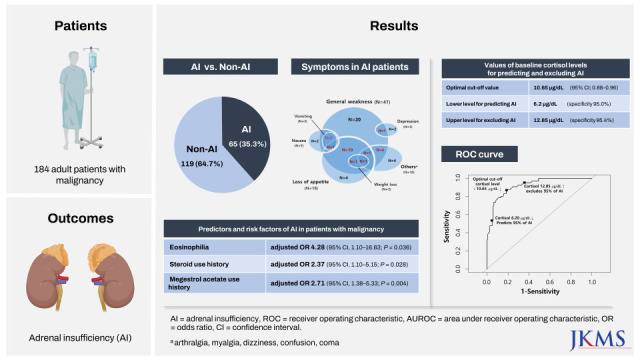1. Bergthorsdottir R, Leonsson-Zachrisson M, Odén A, Johannsson G. Premature mortality in patients with Addison’s disease: a population-based study. J Clin Endocrinol Metab. 2006; 91(12):4849–4853. PMID:
16968806.

2. Bensing S, Brandt L, Tabaroj F, Sjöberg O, Nilsson B, Ekbom A, et al. Increased death risk and altered cancer incidence pattern in patients with isolated or combined autoimmune primary adrenocortical insufficiency. Clin Endocrinol (Oxf). 2008; 69(5):697–704. PMID:
18727712.

3. Biddie SC, Conway-Campbell BL, Lightman SL. Dynamic regulation of glucocorticoid signalling in health and disease. Rheumatology (Oxford). 2012; 51(3):403–412. PMID:
21891790.

4. Laugesen K, Broersen LH, Hansen SB, Dekkers OM, Sørensen HT, Jorgensen JO. Management of endocrine disease: glucocorticoid-induced adrenal insufficiency: replace while we wait for evidence? Eur J Endocrinol. 2021; 184(4):R111–R122. PMID:
33449912.

5. Almeida MQ, Mendonca BB. Adrenal insufficiency and glucocorticoid use during the COVID-19 pandemic. Clinics (Sao Paulo). 2020; 75:e2022. PMID:
32555949.

6. Karangizi AH, Al-Shaghana M, Logan S, Criseno S, Webster R, Boelaert K, et al. Glucocorticoid induced adrenal insufficiency is common in steroid treated glomerular diseases - proposed strategy for screening and management. BMC Nephrol. 2019; 20(1):154. PMID:
31060510.

7. Redman BG, Pazdur R, Zingas AP, Loredo R. Prospective evaluation of adrenal insufficiency in patients with adrenal metastasis. Cancer. 1987; 60(1):103–107. PMID:
3581024.

8. Mitchell J, Barbosa G, Tsinberg M, Milas M, Siperstein A, Berber E. Unrecognized adrenal insufficiency in patients undergoing laparoscopic adrenalectomy. Surg Endosc. 2009; 23(2):248–254. PMID:
19037697.

9. Hirai H, Kuwana K, Kusano Y. Late onset adrenal insufficiency after adrenalectomy due to latent nonclassical 21-hydroxylase deficiency: a case report. Medicine (Baltimore). 2018; 97(33):e11888. PMID:
30113485.
10. Percik R, Shlomai G, Tirosh A, Tirosh A, Leibowitz-Amit R, Eshet Y, et al. Isolated autoimmune adrenocorticotropic hormone deficiency: from a rare disease to the dominant cause of adrenal insufficiency related to check point inhibitors. Autoimmun Rev. 2020; 19(2):102454. PMID:
31838158.

11. Oray M, Abu Samra K, Ebrahimiadib N, Meese H, Foster CS. Long-term side effects of glucocorticoids. Expert Opin Drug Saf. 2016; 15(4):457–465. PMID:
26789102.

12. Munro V, Elnenaei M, Doucette S, Clarke DB, Imran SA. The effect of time of day testing and utility of 30 and 60 minute cortisol values in the 250 mcg ACTH stimulation test. Clin Biochem. 2018; 54:37–41. PMID:
29458002.

13. Reddy P. Clinical approach to adrenal insufficiency in hospitalised patients. Int J Clin Pract. 2011; 65(10):1059–1066. PMID:
21762316.

14. Kim J. The impact of hospitalist care in Korea. J Korean Med Sci. 2019; 34(25):e177. PMID:
31243936.

15. Kuang FL. Approach to patients with eosinophilia. Med Clin North Am. 2020; 104(1):1–14. PMID:
31757229.

16. Deng R, Bumbaca D, Pastuskovas CV, Boswell CA, West D, Cowan KJ, et al. Preclinical pharmacokinetics, pharmacodynamics, tissue distribution, and tumor penetration of anti-PD-L1 monoclonal antibody, an immune checkpoint inhibitor. MAbs. 2016; 8(3):593–603. PMID:
26918260.

17. Sunshine J, Taube JM. PD-1/PD-L1 inhibitors. Curr Opin Pharmacol. 2015; 23:32–38. PMID:
26047524.

18. Li B, Chan HL, Chen P. Immune checkpoint inhibitors: basics and challenges. Curr Med Chem. 2019; 26(17):3009–3025. PMID:
28782469.

19. Ahn SY, Kim HK, Kang HC, Kim M, Song GY, Jung SH, et al. Adrenal insufficiency in hospitalized patients with multiple myeloma. Leuk Lymphoma. 2021; 62(2):501–503. PMID:
33135942.

20. Yoon JH, Ahn SY, Jung SH, Lee JJ, Choi W, Park JY, et al. Prevalence and risk factors for adrenal insufficiency in patients with multiple myeloma receiving long-term chemotherapy including corticosteroids: a retrospective cohort study. Biomed Res Int. 2021; 2021:2330417. PMID:
34938804.

21. Mouloudi E, Katsanoulas K, Aslanidis TH, Lampiri CL, Papageorgiou CH, Tholioti TH, et al. Eosinophilia: an early marker of adrenal insufficiency in critically ill patients with septic shock? Greek e J Perioper Med. 2018; 17(a):61–70.
22. Angelis M, Yu M, Takanishi D, Hasaniya NW, Brown MR. Eosinophilia as a marker of adrenal insufficiency in the surgical intensive care unit. J Am Coll Surg. 1996; 183(6):589–596. PMID:
8957461.
23. Beishuizen A, Vermes I, Hylkema BS, Haanen C. Relative eosinophilia and functional adrenal insufficiency in critically ill patients. Lancet. 1999; 353(9165):1675–1676. PMID:
10335792.

24. Miller WL. The hypothalamic-pituitary-adrenal axis: a brief history. Horm Res Paediatr. 2018; 89(4):212–223. PMID:
29719288.

25. Paragliola RM, Papi G, Pontecorvi A, Corsello SM. Treatment with synthetic glucocorticoids and the hypothalamus-pituitary-adrenal axis. Int J Mol Sci. 2017; 18(10):E2201. PMID:
29053578.

26. Gjerstad JK, Lightman SL, Spiga F. Role of glucocorticoid negative feedback in the regulation of HPA axis pulsatility. Stress. 2018; 21(5):403–416. PMID:
29764284.

27. García-Castells AM, Argente-Pla M, García-Malpartida K, Querol-Ripoll R, Merino-Torres JF. Adrenal insufficiency induced by megestrol acetate: report of two cases. Endocrinol Nutr. 2015; 62(10):515–516. PMID:
26250842.

28. González Villarroel P, Fernández Pérez I, Páramo C, Gentil González M, Carnero López B, Vázquez Tuñas ML, et al. Megestrol acetate-induced adrenal insufficiency. Clin Transl Oncol. 2008; 10(4):235–237. PMID:
18411198.

29. Bulchandani D, Nachnani J, Amin A, May J. Megestrol acetate-associated adrenal insufficiency. Am J Geriatr Pharmacother. 2008; 6(3):167–172. PMID:
18775392.

30. Manosroi W, Phimphilai M, Khorana J, Atthakomol P. Diagnostic performance of basal cortisol level at 0900-1300h in adrenal insufficiency. PLoS One. 2019; 14(11):e0225255. PMID:
31738804.

31. Wachter RM. An introduction to the hospitalist model. Ann Intern Med. 1999; 130(4 Pt 2):338–342. PMID:
10068402.

32. Ñamendys-Silva SA, González-Herrera MO, Texcocano-Becerra J, Herrera-Gómez A. Hypoalbuminemia in critically ill patients with cancer: incidence and mortality. Am J Hosp Palliat Care. 2011; 28(4):253–257. PMID:
21057142.










 PDF
PDF Citation
Citation Print
Print




 XML Download
XML Download